
Farmington is a house near Charlottesville, in Albemarle County, Virginia, that was greatly expanded by a design by Thomas Jefferson that Jefferson executed while he was President of the United States. The original house was built in the mid-18th century for Francis Jerdone on a 1,753-acre (709 ha) property. Jerdone sold the land and house to George Divers, a friend of Jefferson, in 1785. In 1802, Divers asked Jefferson to design an expansion of the house. The house, since greatly enlarged, is now a clubhouse.

Blenheim is a historic home and farm complex located at Blenheim, Albemarle County, Virginia. The main house was built by politician and diplomat Andrew Stevenson in 1846, and is a 1 1/2-story, six bay, gable-roofed frame building with Gothic Revival and Greek Revival style details. It has an ell at the rear of the west end. The front facade features a pair of one-story tetrastyle porches with pairs of Doric order piers. A notable outbuilding is the square "Athenaeum", a one-story, one-room, frame Greek Revival building with a pyramidal hipped roof and portico supported on Doric piers. Also on the property are a frame kitchen/laundry, a "chapel" or schoolhouse, and two smoke houses. Also on the property are two dwellings, one of which is supposed to have been built to accommodate Justice Roger B. Taney on his visits to Blenheim. The main house and many of the outbuildings were built during the ownership of Representative Andrew Stevenson (1784-1857), who purchased the property in 1846.

Gallison Hall is a historic home located near Charlottesville in Albemarle County, Virginia, United States. It was designed by the architect Stanhope Johnson in the Georgian Revival style, and built between 1931 and 1933. It consists of a 2½-story, five-bay, brick center section with a steeply pitched hipped roof, flanked by 1 1/2-story, three-bay, gable-roofed wings connected by hyphens. At each end are a seven-bay brick arcades connected to a 1 1/2-story two-bay gable-roofed garage on the east and an identical arcade connected to an octagonal gazebo brick on the west. The house is set among English gardens designed by Charles F. Gillette.

Mechum River Farm is an historic manor house and farm located near Charlottesville, Albemarle County, Virginia. The original house was built about 1820 presumably by a Burch family member, then updated and expanded about 1850 in the Gothic Revival style during the ownership of John C. Burch and Lucinda E. Gay Burch. It is a 1 1/2-story, three bay, brick hall and parlor plan dwelling set on a raised basement with a solid brick foundation and a side gable roof. It features a hipped-roof portico over the central single-leaf entry. It has a rear addition built about 1920 and an extension to that built in 1976. Also on the property are a contributing barn, shed, wood shed, Delco shed, smokehouse, chicken coop, privy, shed, and family cemetery.

Redlands is a historic home located near Covesville, Albemarle County, Virginia. It was built between about 1798 and 1808, and is a rectangular two-story, five bay, brick structure covered by a hipped roof in the Federal style. It features a Tuscan order front porch. Its interior is notable for its fine Adamesque woodwork. The master builder of the house was Martin Thacker, of neighboring Cedar Grove. It was built for Robert Carter, grandson of John Carter, around the time of his marriage to Mary Eliza Coles of neighboring Enniscorthy.
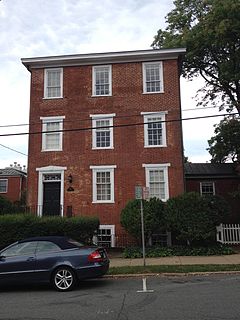
Carter–Gilmer House is a historic home located at Charlottesville, Virginia. It was built about 1820, and is a three-story, three bay, Federal style brick townhouse dwelling. The house has been divided into apartments.

Enderly is a historic home located at Charlottesville, Virginia. It was built in 1859–1860, and is a two-story, three bay, Greek Revival style brick dwelling. It has an original one-story rear wing, later expanded to two stories in the 20th century. A single-story Colonial Revival front porch replaced the original portico.
The Ficklin–Crawford Cottage was a historic house located at Charlottesville, Virginia. It was built sometime between 1865 and 1886, and was a 1 1/2-story, three-bay, frame dwelling with Gothic Revival style decorative details. It had a steep bellcast gable roof with deeply projecting eaves. It originally stood on the southwest corner of Belmont Avenue and Castalia Street, and moved to its final site in 1929.
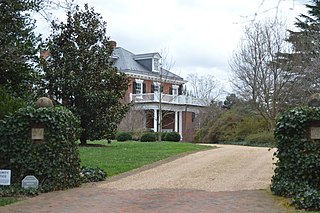
Four Acres is a historic home located at Charlottesville, Virginia. It was built in 1910, and is a 2+1⁄2-story, three-bay, Colonial Revival-style brick dwelling. It sits in a raised basement and has a slate hipped roof. The front facade features a four-columned, Ionic order portico.
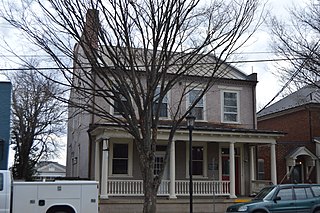
Paxton Place is a historic home located at Charlottesville, Virginia. It was built about 1824, and is a 2 1/2-story, four-bay, Federal style brick dwelling. It has a side gable roof and two interior chimneys connected by a curtain. The house has been occupied by the Shisler Funeral Home and the Loyal Order of Moose Lodge.
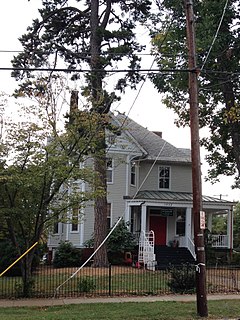
Dabney–Thompson House is a historic home located at Charlottesville, Virginia. It was built in 1894, and is a two-story Queen Anne style frame dwelling. It is sheathed in weatherboard and features a steeply-pitched hipped roof with tall gables over all four projecting bays. The house has projecting eaves and verges and decoratively-sawn exposed rafter ends. It is pierced by three chimneys with corbelled caps. It was built by Richard Heath Dabney, Professor of History and later Dean of the Graduate School of Arts and Sciences at the University of Virginia, father of Virginius Dabney (1901-1995). Dabney sold the house in 1907. The house is occupied by the Montessori School of Charlottesville.

House at Pireus is a historic home located at Charlottesville, Virginia. It was built about 1830, and is a small 1 1/2-story, two bay, vernacular cottage. It sits on a full basement and has a hipped gambrel roof of standing seam metal. The house has a central stone and brick chimney. It was probably moved to its present location during the last quarter of the 19th century.
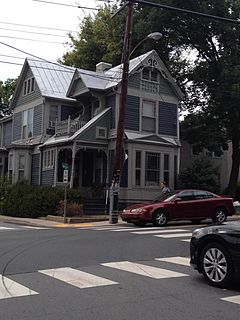
The King–Runkle House is a historic home located at Charlottesville, Virginia. It was built in 1891, and is a two-story, Late Victorian style frame dwelling with a two-story rear wing. It is sheathed in weatherboard and has a steeply pitched gable roof. The house features a simple one-story semi-octagonal bay window, ornamented porches and a projecting pavilion, and Eastlake movement gable ornamentation.

McConnell–Neve House is a historic home located at Charlottesville, Virginia. It was built in 1894, and is a two-story, three bay, Late Victorian style frame dwelling with a 1 1/2-story wing. It is sheathed in wooden shingles. It features high-pitched hipped roof, irregular silhouette, and slender three-story octagonal tower with steep pyramidal roof. The house has been divided into apartments.

The Timberlake–Branham House is a historic home located in Charlottesville, Virginia. It was built in 1886, and is a two-story, three-bay, single-pile I-house dwelling. It is sheathed in weatherboard and sits on a low brick foundation. It features a two-story semi-octagonal addition at the eastern end and a wing at the southwestern rear corner. The house is occupied by the Dabney Foundation for Elders.

Rose Cottage/Peyton House is a historic home located at Charlottesville, Virginia. It was built in 1856, as a simple three-bay, single-pile, two-story rectangular frame dwelling. The house is sheathed in weatherboard. Later 20th century additions include a single story Colonial Revival porch; matching one-story, one room wings; and a two-story, perpendicular house joined by and enclosed porch.

Piereus Store is a historic commercial building located at Charlottesville, Virginia. It was built between 1835 and 1840, and is a two-story, two-bay, brick building measuring two rooms deep. It has a gable roof and a single story Victorian front porch. It is one of two houses remaining from the "Piereus" phase of industrial development along the Rivanna River.

John Vowles House are two adjoined historic homes located at Charlottesville, Virginia. It was built in 1824, and consists of two two-story, three-bay, gable-roofed Federal style brick town houses. Both houses feature decorative cornices and original interior woodwork. To the rear of 1113 West Main is a small 1 1/2-story, "L"-shaped, gable-roofed brick outbuilding built as a kitchen and added in the 1920s.

Montebello is a historic home located at Charlottesville, Virginia. The central section was built in 1819–1820, and consists of three-part facade, with a three bay, two-story central block with single-story flanking wings. The original section has a single pile, brick I-house plan with a central hall flanked by a room on each side. Also on the property is a contributing 1 1/2-story, brick, two-car garage. The house was built by John M. Perry, one of the workmen who worked with Thomas Jefferson at Monticello and on his many building projects at the University of Virginia. The University of Virginia purchased the house and property in 1963 and it currently serves as a residence for faculty.

Albemarle County Courthouse Historic District is a historic courthouse and national historic district located at Charlottesville, Virginia. The district encompasses 22 contributing buildings and 1 contributing object centered on Court Square. The original section of the courthouse was built in 1803 in the Federal style and is now the north wing. The courthouse is a two-story, five-bay, "T" shaped brick building with a Greek Revival style portico. Other notable buildings include the Levy Opera House, Number Nothing, Redland Club, and Eagle Tavern.























